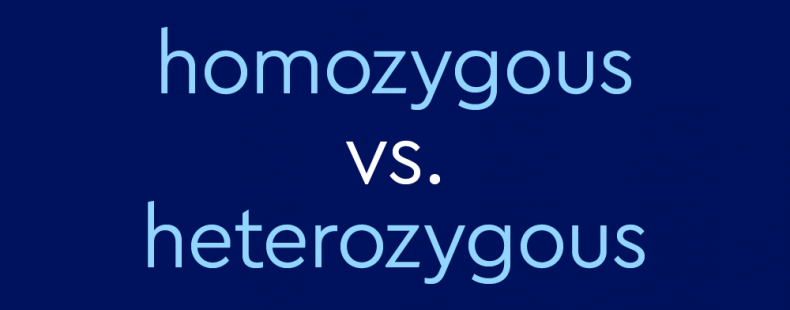Heterozygous and homozygous are terms used in biology and genetics to indicate whether a living thing has two of the same copies of a gene for a particular trait, or whether it has two different ones.
For example, let’s say one parent has black hair, and one has brown hair. One of their children might get two copies of the black hair gene, while another child might get one copy of the black hair gene and one copy of the brown hair gene. The child with two copies of the gene for black hair is said to be homozygous for the trait of hair color, while the child with one of each is said to be heterozygous for the trait.
But heterozygous and homozygous don’t only relate to hair, or only to humans. All living organisms pass on traits through genes, and can end up being heterozygous or homozygous for particular traits.
In this article, we’ll break down the difference, give you simple definitions of the key terms (like chromosome and allele), and provide several simple examples.
⚡ Quick summary
An organism that has the same two copies of a gene is considered homozygous for that trait, while an organism that has different copies of a gene for a particular trait is considered heterozygous for that trait. In plant and animal breeding, such organisms can be called homozygotes and heterozygotes.
What does homozygous mean?
Homozygous (and its less common form homozygotic) means “relating to a cell that has two identical alleles for a particular gene at corresponding positions on homologous chromosomes.”
Let’s break that down. Chromosomes carry genes. A gene is a segment of DNA—a string of code, really—that determines an organism’s characteristics (such as hair color or leaf shape). Alleles are different forms of the same gene. For example, we all have genes that determine our eye color. The different eye colors—brown, blue, green, etc.—are due to different alleles of the same gene.
Chromosomes carry genes in linear order, so for an organism to be homozygous, it has to have the same allele for the same gene at the same point in the chromosome.
When you get your genes from your parents, you get them in pairs—one copy of each gene (that is, one allele) from each parent. If your parents both pass down the same allele to you, you’re homozygous for that trait.
Another example is flower color, which is often determined by alleles. Let’s imagine a plant with an allele that results in a yellow color and another allele that results in a red color. If a plant has two copies of the allele for yellow or two copies of the allele for red, it’s homozygous, and it’ll be the color dictated by those two genes.
No organism is totally homozygous on all genes—genes are much too complex. So, an organism isn’t considered to be homozygous overall—being homozygous only applies to one trait at a time. That’s why it’s usually phrased as homozygous for a specific trait.
What is a homozygote?
A homozygote is “an organism with identical pairs of genes with respect to any given pair of hereditary characters, and therefore breeding true for that character.” In other words, it’s an organism that has two copies of the same allele for a particular trait. Which means that it’s guaranteed to pass on that trait to its offspring.
This is particularly useful for breeders of plants and animals. When you’re trying to control the form of an organism through selective breeding, you need to make sure the trait you want is passed down. Getting two parents that are homozygous for the trait ensures that it’ll be passed down, because there are no other copies of the allele in those genes other than the ones you want.
What does heterozygous mean?
Heterozygous (and its less common form heterozygotic) means “relating to a cell that has two different alleles for a particular gene at corresponding positions on homologous chromosomes.”
Remember, a chromosome carries genes in linear order; a gene is a segment of code that dictates what trait will develop; and alleles are forms of a gene. For an organism to be heterozygous, it has to have a different allele for the same gene at the same point in the chromosome.
Let’s go back to flowers. The offspring of a flower with one allele for yellow and one allele for red could inherit one of each of these—one for yellow and one for red. Depending on how the gene works, it might result in an orange flower or in a flower that’s just yellow or in one that’s just red—but with the potential to have offspring of a different color. Such a flower would be said to be heterozygous for flower color, because it’s got a copy of one yellow allele and one red allele.
Humans can be heterozygous for traits as well. To oversimplify it, you might inherit one copy of the “get freckles” allele and one copy of the “don’t get freckles” allele, meaning you may or may not get freckles as a result.
When an organism is heterozygous for a particular trait, how that trait develops or is expressed depends on things like whether a gene is dominant or recessive, as well as simple mathematical odds.
What is a heterozygote?
A heterozygote is an organism that’s heterozygous for a particular trait. Remember, when we use these words, we’re applying them in the context of individual traits, not entire organisms, because no one organism is heterozygous overall.
When breeding a vegetable for a specific trait, it often takes a lot of crossbreeding of heterozygotes to result in the homozygote you’re hoping for.
Where do homozygous and heterozygous come from?
The root of both homozygous and heterozygous is zygo-, meaning “yoke” or “yoked,” as in “paired together.” The suffix -ous is used to form adjectives. The difference is in the beginning: the Greek hetero- means “different,” and the Greek homo- means “same.” This is a great way to remember the difference and what this means in practical terms.
How to use homozygous vs. heterozygous
Both words are commonly followed by the word for and the specific trait. To be homozygous for a trait is to have identical pairs of the genes (called alleles) that determine how it develops. To be heterozygous for a trait is to have different alleles for it.
Being homozygous for a trait means that it will always turn out the same. But being heterozygous means that the trait can develop in different ways.
Remember, an organism isn’t said to be homozygous or heterozygous overall—just for a single trait.
Examples of homozygous and heterozygous used in a sentence
Here are some examples that illustrate the difference between homozygous and heterozygous.
- If you have two copies of the allele for blonde hair, you are homozygous for that trait.
- Having one copy of the allele for blonde hair and one copy of the allele for brown hair makes you heterozygous for hair color.
- Being heterozygous for a recessive trait like blue eyes means you have a pretty low chance of developing that trait, but being homozygous for it means that you’re certain to develop it.














